Purpose of Study
It is important to understand what factors should be added to income statements in order to overcome the gap in auditors’ approach to analysis of two types of methods.
Rationale for Study
Each method has its impact and standard regarding costs, nature of materials, and structure. Income statements could be organized according to absorption and variable costing methods.
Context/Background
Income statements are the financial operations that could be organized in two different ways or presented as the parts of annual or regular reports developed by company managers.
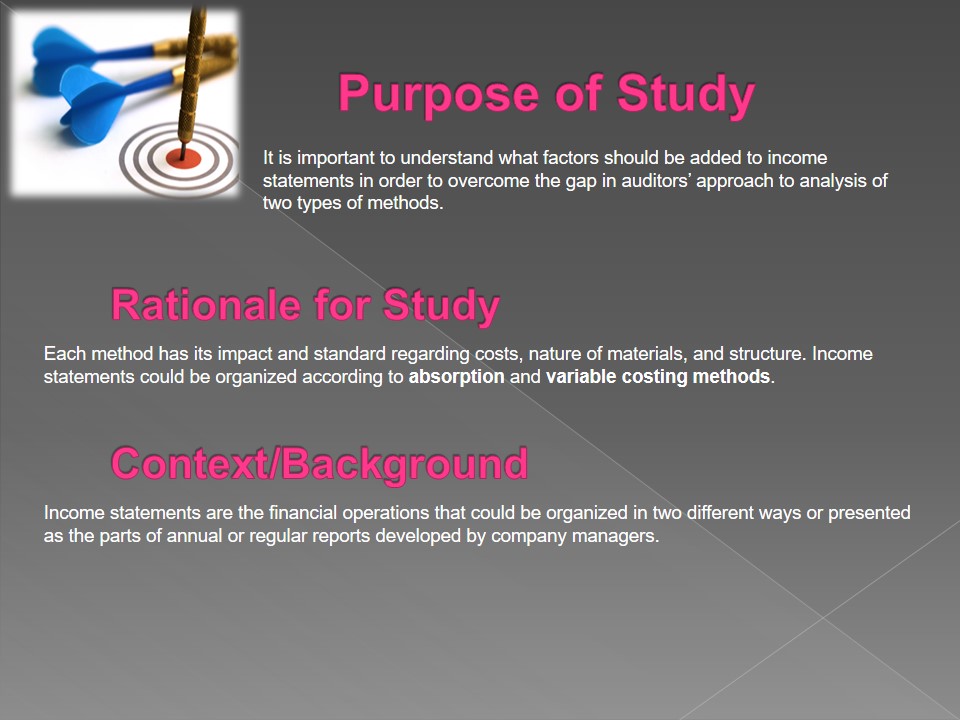
Research Objectives
- To identify factors of income statements.
- To investigate changes in the auditing standards.
- To analyze variable and absorption costing methods.
- What is the gap between absorption and variable methods of organizing income statements?
- Who can profiteer from this gap?
- What conditions are associated with deepening the gap?
- What are the benefits of eliminating the determined gap?
- What indicators can be added to income statements and auditing reports to address the gap?
- How can indicators influence the auditing procedures and the shareholders’ understanding of performance?
Contributions of Research
Research aids understanding of the main principles of financial statements and clarifies the main indicators of income statements.
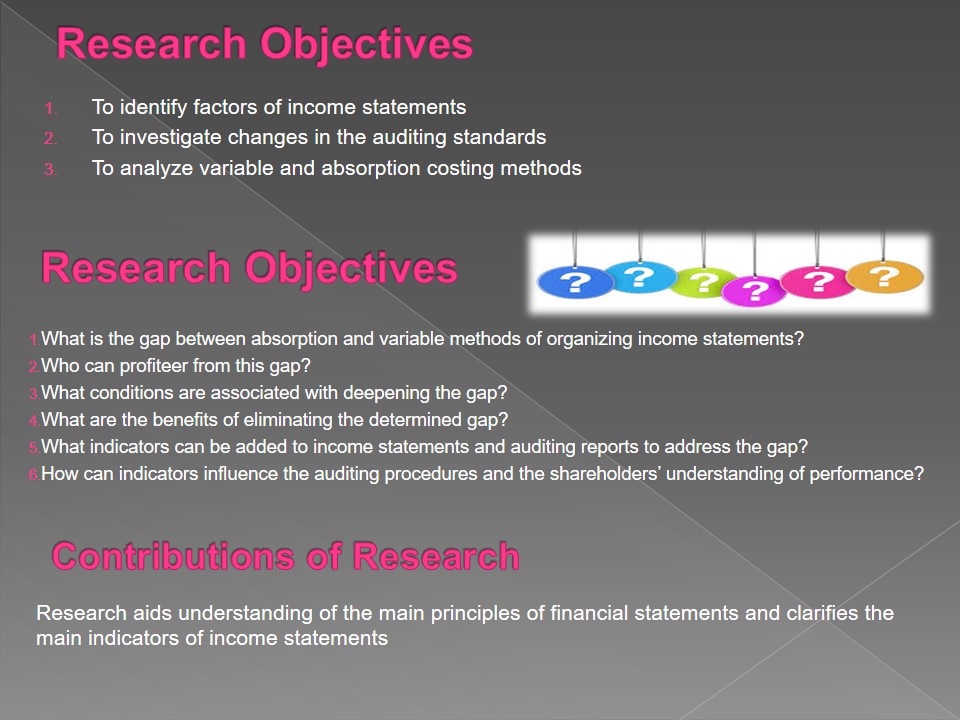
Literature Review
Seminal Papers
Agbejule, Adebayo and Jonna Huusko. “The Benefits of Management Accounting Practices in Manufacturing and Service Firms: a Finnish Study.” International Journal of Services, Economics and Management 3.4 (2011): 354-375. Print.
Angelakis, George, Nikolaos Theriou, and Iordanis Floropoulos. “Adoption and Benefits of Management Accounting Practices: Evidence from Greece and Finland.” Advances in Accounting 26.1 (2010): 87-96. Print.
Yalcin, Selcuk. “Adoption and Benefits of Management Accounting Practices: An Intercountry Comparison.” Accounting in Europe 9.1 (2012): 95-110. Print.
Recent Research
Hasan, Salim. “Variable Costing and Its Applications in Manufacturing Company.” International Scholar Journal of Accounting and Finance 5.1 (2015): 11-23. Print.
Weygandt, Jerry J, Paul D Kimmel, and Donald E Kieso. Financial and Managerial Accounting, New York: John Wiley & Sons, 2015. Print.
Research Gap
The gap in determining the factors that can improve the use of absorption and variablecosting methods for accounting and auditing exists and has to be discussed in the offered study.

Theoretical Framework
The concept of income statements has a long history.
Income statements are financial statements that indicate organizational revenues and expenses.
There are two methods to analyze income statements (Marshall, McManus, and Viele 513):
- Absorption costing is a full method that is used to identify income statements when the product is sold.
- Variable costing is the method that is frequently used to cover the income statements during a certain period of work when these expenses occur.
Lack of factors for income statements leads to ineffective auditing. Therefore, it is necessary to identify the standards and investigate variable and absorption costing methods to clarify what is the best option for managers to rely on.
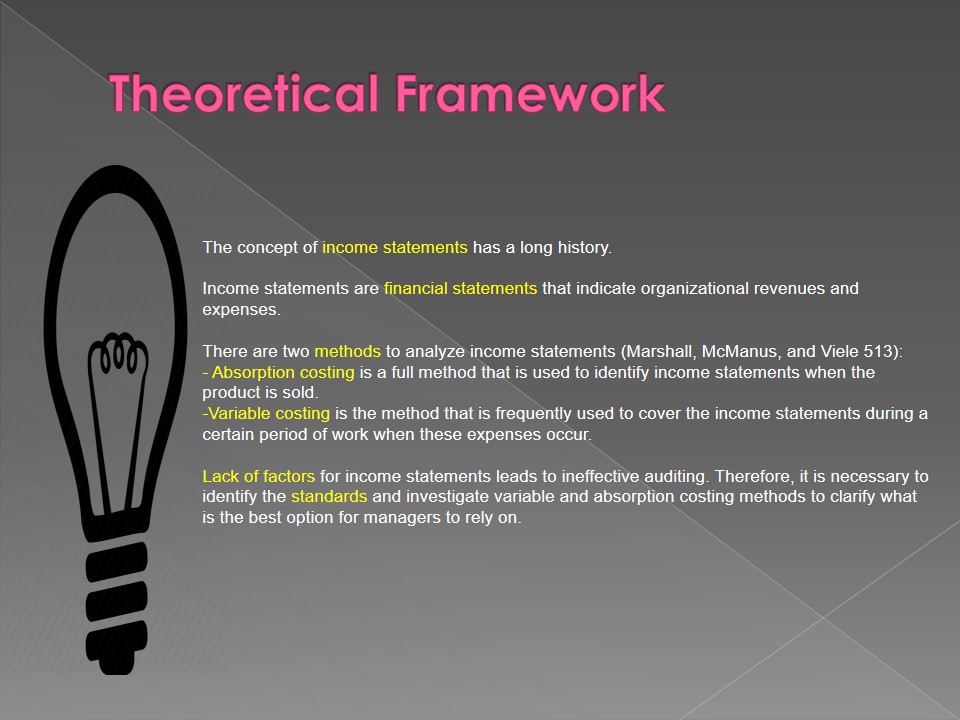
Conceptual Framework
Income statements have to be properly organized by companies’ managers.
There are two methods to organize income statements depending on their purposes.
- Variable costing.
- Absorption costing.
What are the financial indicators and standards of both methods?
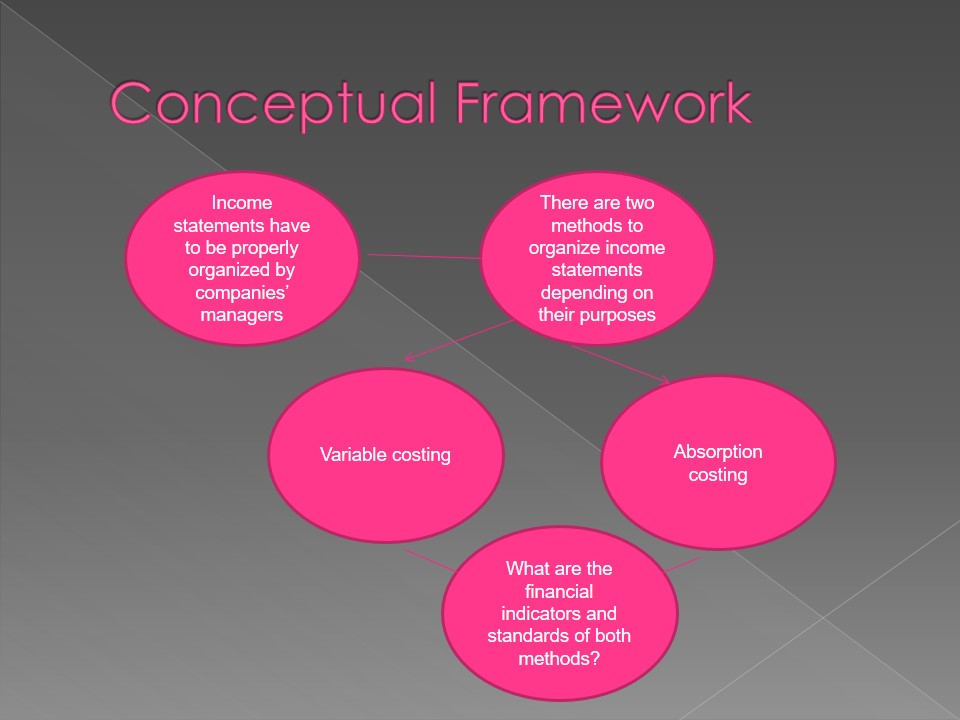
Methodology
- Design:
- Mixed methods develop a complex analysis of the data and make relevant conclusions on the topic.
- Qualitative and quantitative methods helps to study the offered problem and address the aim of the investigation.
- Qualitative methods investigate the companies from different industries and gather different opinions about the methods’ gap.
- Case study is the qualitative method to introduce the main characteristics of variable and absorption income statements.
- Quantitative methods support the conclusions about the income statements indicators with the numerical data.
- A questionnaire is the method based on the Likert scale to transform the qualitative information into quantitative if possible.
- Measures:
- Accountants and auditors responsibilities (Angelakis, Theriou, and Floropoulos 87).
- Usage of both costing methods creates barriers (Ruiz-de-Arbulo-Lopez, Fortuny-Santos, and Cuatrecasas-Abros 648).
- Income statement analysis may have a number of forms (Agbejule and Huusko 358; Drury 23).
- Data Collection:
- All data is gathered from case studies and questionnaires that are found to meet the exclusive and inclusion criteria.
- Data Analysis:
- Analysis of the literature and the company’s performance.
- Analysis of different income statements based on variable and absorption costing.
- Frequency of Distribution.
- Validity:
- The aim and objectives which are properly developed;
- Research questions are answered;
- Qualitative and quantitative methods (questionnaires and case studies) are used;
- An outline of the outcomes which are inherent to research.
- Ethical Issues:
- Confidentiality of the participants and the promotion of no harm are the main guarantees offered to the participants of the questionnaire.
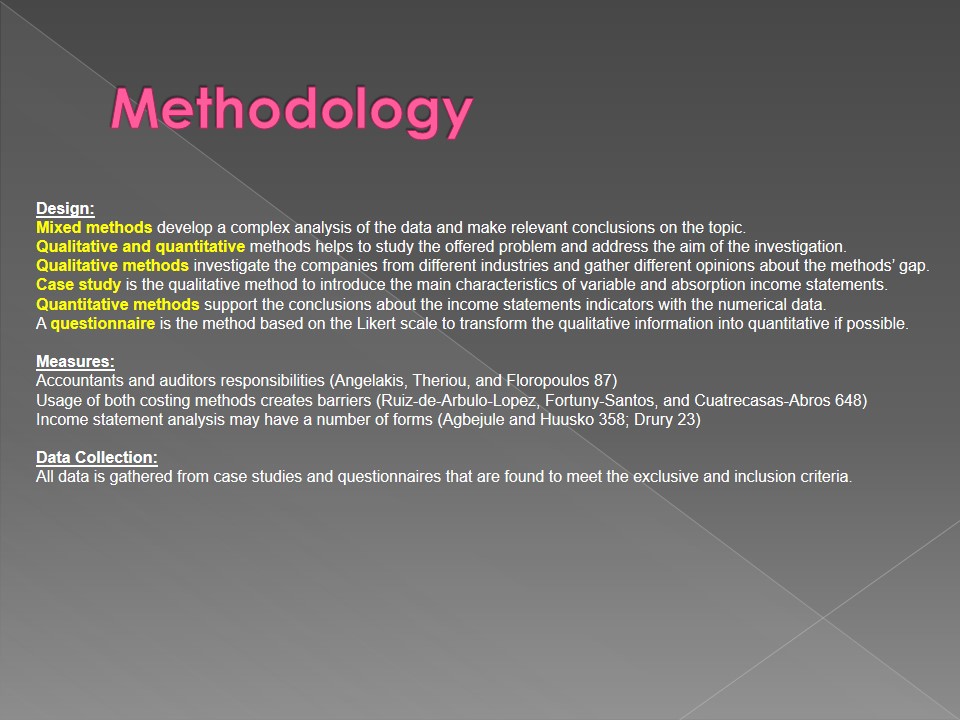
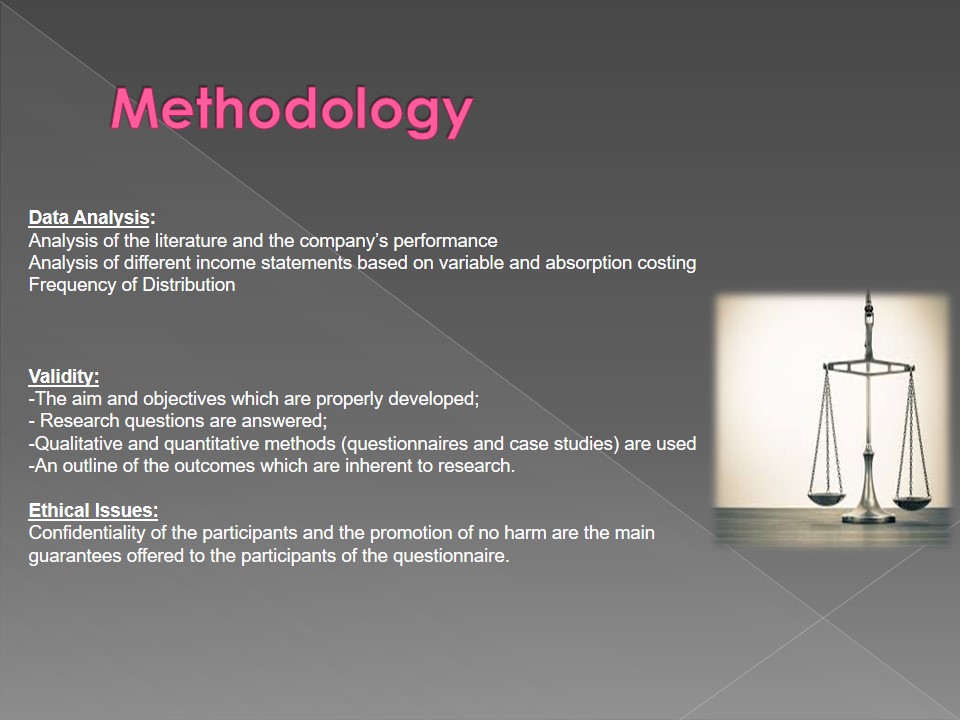
Implications
- Expected Results:
- Numerical data should be gathered in regards to company performance, expected drawbacks, and possible problems with absorption and variable methods. The audited standard should not be violated when new indicators are added to income statements.
- Theoretical Contributions:
- The study helps to indicate if the gap in research about income statements could be explained and improved.
- Practical Implications:
- The development of financial indicators for income statements that are organized in two different ways (variable costing and absorption costing) should help to improve the work of managers and report performance.
- Limitations:
- Wrong calculations, poorly developed accounting methods, and false scoring systems could be used. It is necessary to test and re-test the results to make sure that the same correct calculations and numbers are obtained.
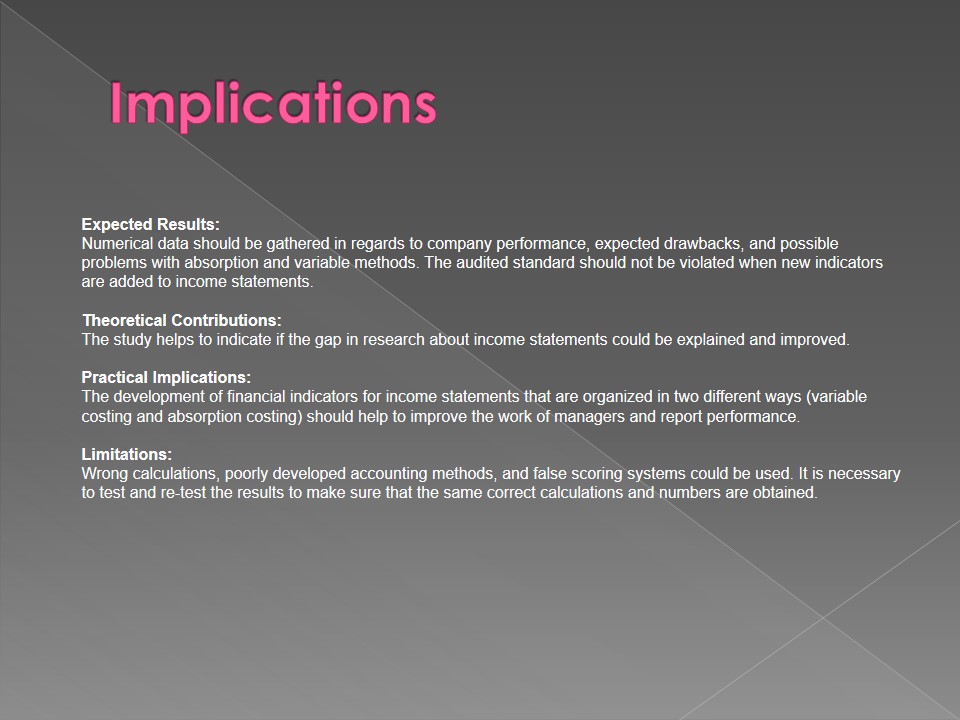
Works Cited
Agbejule, Adebayo and Jonna Huusko. “The Benefits of Management Accounting Practices in Manufacturing and Service Firms: a Finnish Study.” International Journal of Services, Economics and Management 3.4 (2011): 354-375. Print.
Angelakis, George, Nikolaos Theriou, and Iordanis Floropoulos. “Adoption and Benefits of Management Accounting Practices: Evidence from Greece and Finland.” Advances in Accounting 26.1 (2010): 87-96. Print.
Drury, Colin. Management and Cost Accounting, New York: Springer, 2013. Print.
Hasan, Salim. “Variable Costing and Its Applications in Manufacturing Company.” International Scholar Journal of Accounting and Finance 5.1 (2015): 11-23. Print.
Marshall, David, M., Wayne W. McManus, and Daniel F. Viele. Accounting: What the Numbers Mean. New York: McGraw-Hill, 2011. Print.
Ruiz-de-Arbulo-Lopez, Patxi, Jordi Fortuny-Santos, and Lluis Cuatrecasas-Arbos. “Lean Manufacturing: Costing the Value Stream.” Industrial Management & Data Systems 113.5 (2013): 647-668. Print.
Yalcin, Selcuk. “Adoption and Benefits of Management Accounting Practices: An Intercountry Comparison.” Accounting in Europe 9.1 (2012): 95-110. Print.
Weygandt, Jerry J, Paul D Kimmel, and Donald E Kieso. Financial and Managerial Accounting, New York: John Wiley & Sons, 2015. Print.